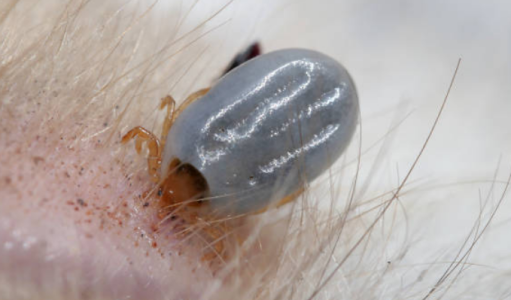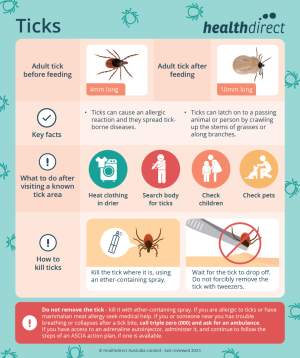Pet owner's horrifying discovery could cost Aussies $1,700
By
Gian T
- Replies 1
As we enjoy our pets' company, it's important to stay aware of the hidden dangers around us.
A recent incident involving a pet owner has reminded us of the possible costs, both financial and emotional, that can arise.
Such situations highlight the need for vigilance in ensuring our pets' safety.
Rose, a resident of NSW's far south coast, was enjoying a cuddle with her two-year-old dog, Boba Fett, when she felt an unwelcome guest near his tail.
To her horror, she discovered an engorged tick, comparable in size to a 10-cent coin, firmly attached to her beloved pet.
'I just happened to be cuddling him, and I noticed that near his tail at the base of his butt, there was a pretty hefty tick there,' she said.
Despite Boba Fett not venturing into dense bushland recently, the large labrador/staffy/blue heeler mix had somehow encountered the deadly paralysis tick.
'He was actually not showing any signs… the only thing that I noticed was that he wasn’t jumping up on my bed, which he usually sleeps on with me, but that was the only thing that sort of made me feel like maybe he wasn’t feeling his best,' she added.
However, the situation took a dire turn shortly after Rose and her brother removed the tick.
Boba Fett began to drool excessively and struggled to stand, prompting an emergency visit to the local vet.
There, they were informed that Boba Fett was indeed showing signs of paralysis.
'I was quite confused because we do give him his NexGard Spectra,' Rose said.
The vet clarified that the treatment might not provide complete coverage for the entire month in areas with high tick populations, especially for larger dogs.
After a tense period and administering a serum to counteract the toxin, Boba Fett was allowed to return home to recover.
However, the ordeal left Rose with a staggering $1,700 vet bill, leading her to seek financial assistance through a GoFundMe page.
Paralysis ticks are a prevalent threat in humid, coastal regions of Australia's east coast, particularly from early spring to mid-summer.
Dr Charlie May, an emergency vet, warns that ticks can hitch a ride on our clothes, making even indoor animals vulnerable.
'Ticks can be found in a number of places,' he said.
'We can even bring ticks in on our clothes, which is why we recommend tick prevention for even indoor animals, because it’s really hard to predict…we’re getting ticks earlier and later in the season, so you have to be really careful.'
The toxin released by these parasites can cause life-threatening paralysis, with early signs including weakness, difficulty walking, vomiting, changes in breathing, or excessive drooling.
In response to the incident, Dr Greg Little from Boehringer Ingelheim, the manufacturer of NexGard products, emphasised that NexGard Spectra is proven to control paralysis ticks for five weeks.
He recommended year-round use for dogs in tick-prone areas and stressed that no tick control product can guarantee 100 per cent protection.
Daily tick searches and correct dosage based on the pet's weight are essential for prevention.
This cautionary tale reminds pet owners of the importance of vigilance and proper tick prevention measures.
It's not just about the potential financial burden; it's about the well-being of our cherished pets.
If you suspect your tick prevention method is not working as intended, it's crucial to contact the product's customer care team and report your experience.

Have you ever faced a similar situation? What measures do you take to ensure your pet's safety? Join the conversation and help spread awareness within our community.
A recent incident involving a pet owner has reminded us of the possible costs, both financial and emotional, that can arise.
Such situations highlight the need for vigilance in ensuring our pets' safety.
Rose, a resident of NSW's far south coast, was enjoying a cuddle with her two-year-old dog, Boba Fett, when she felt an unwelcome guest near his tail.
To her horror, she discovered an engorged tick, comparable in size to a 10-cent coin, firmly attached to her beloved pet.
'I just happened to be cuddling him, and I noticed that near his tail at the base of his butt, there was a pretty hefty tick there,' she said.
Despite Boba Fett not venturing into dense bushland recently, the large labrador/staffy/blue heeler mix had somehow encountered the deadly paralysis tick.
'He was actually not showing any signs… the only thing that I noticed was that he wasn’t jumping up on my bed, which he usually sleeps on with me, but that was the only thing that sort of made me feel like maybe he wasn’t feeling his best,' she added.
However, the situation took a dire turn shortly after Rose and her brother removed the tick.
Boba Fett began to drool excessively and struggled to stand, prompting an emergency visit to the local vet.
There, they were informed that Boba Fett was indeed showing signs of paralysis.
'I was quite confused because we do give him his NexGard Spectra,' Rose said.
The vet clarified that the treatment might not provide complete coverage for the entire month in areas with high tick populations, especially for larger dogs.
After a tense period and administering a serum to counteract the toxin, Boba Fett was allowed to return home to recover.
However, the ordeal left Rose with a staggering $1,700 vet bill, leading her to seek financial assistance through a GoFundMe page.
Paralysis ticks are a prevalent threat in humid, coastal regions of Australia's east coast, particularly from early spring to mid-summer.
Dr Charlie May, an emergency vet, warns that ticks can hitch a ride on our clothes, making even indoor animals vulnerable.
'Ticks can be found in a number of places,' he said.
'We can even bring ticks in on our clothes, which is why we recommend tick prevention for even indoor animals, because it’s really hard to predict…we’re getting ticks earlier and later in the season, so you have to be really careful.'
The toxin released by these parasites can cause life-threatening paralysis, with early signs including weakness, difficulty walking, vomiting, changes in breathing, or excessive drooling.
In response to the incident, Dr Greg Little from Boehringer Ingelheim, the manufacturer of NexGard products, emphasised that NexGard Spectra is proven to control paralysis ticks for five weeks.
He recommended year-round use for dogs in tick-prone areas and stressed that no tick control product can guarantee 100 per cent protection.
Daily tick searches and correct dosage based on the pet's weight are essential for prevention.
This cautionary tale reminds pet owners of the importance of vigilance and proper tick prevention measures.
It's not just about the potential financial burden; it's about the well-being of our cherished pets.
If you suspect your tick prevention method is not working as intended, it's crucial to contact the product's customer care team and report your experience.
Key Takeaways
- An Aussie woman encountered a hefty vet bill after her dog was affected by a paralysis tick despite receiving tick treatment.
- Vets warn that tick prevention is crucial even for indoor pets, as ticks can attach to animals from a variety of environments, not just dense bushland.
- NexGard Spectra is stated to control paralysis ticks effectively for five weeks, but no tick control product can guarantee 100 per cent protection.
- Pet owners are encouraged to ensure proper dosage based on their pet's weight and to conduct daily tick searches as recommended by the Australian Paralysis Tick Advisory Panel.









